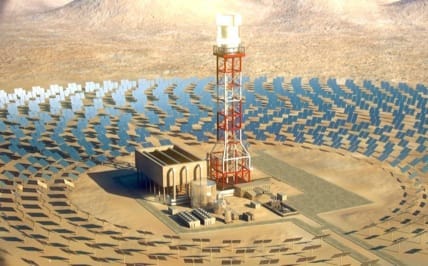Concentrated Solar Power (CSP)
The Other Kind of Solar PowerWhen you think of Solar Power you usually think of photovoltaic panels. However there is an alternative method to generate electricity from sunlight which has even greater potential.
These Concentrated Solar Power (CSP) systems use mirrors (called heliostats) to direct a concentrated large area of sunlight, onto a small area. Electrical power is produced when the concentrated light is converted to heat, which drives a steam turbine connected to an electrical power generator.
Such a project is in the final stages of construction right here in our own Southern California area. The Ivanpah Solar Thermal Project is located adjacent to Interstate 15 at Ivanpah Dry Lake, California. The Ivanpah project is comprised of three new solar thermal power towers which generate steam for three 110 Mega watt (MW) to 126 MW steam turbine generators. Each over 400-foot tall solar power tower will receive solar energy from approximately 60,000 heliostats.
The Ivanpah project is anticipated to be the largest solar thermal installation in the world at the time of completion.
Technology
Ivanpah will produce electricity the same way that most of the world’s electricity is produced – by creating high temperature steam to turn a conventional turbine. However, instead of burning fossil fuels to create the steam, it uses the clean and infinite sun as fuel.
At the heart of BrightSource’s proprietary power-tower solar thermal system is an innovative solar field design, optimization software and a control system that allow for the creation of high temperature steam.
At Ivanpah, over 300,000 software-controlled mirrors will track the sun in two dimensions and reflect the sunlight to boilers that sit atop three 459 foot tall towers. When the concentrated sunlight strikes the boilers’ pipes, it heats the water to create superheated steam.
This high-temperature steam is then piped from the boiler to a standard turbine where electricity is generated.
From there, transmission lines will carry the power to homes and businesses.

Ivanpah at a Glance
Location: Ivanpah Dry Lake, CA
Size: Approx. 3,500 acres of federal land
Power Production: 377 MW
Homes Served Annually: 140,000
Customers: PG&E and Southern California Edison
Partners: NRG, Google, Bechtel Corporation, and the Department of Energy
Construction Commenced October 2010
Expected Completion Date 2013
Solar-thermal power stations have several advantages over solar-photovoltaic projects. They are typically built on a much larger scale, and historically their costs have been much lower. Compared with other renewable sources of energy, they are probably best able to match a utility’s electrical load, says Nathaniel Bullard of New Energy Finance, a research firm. “They work best when it is hottest and demand is greatest”.
Besides these benefits, the main drivers for the growth of the solar-thermal industry are moves to limit carbon-dioxide emissions and requirements to increase the proportion of electricity produced from renewable sources. According to New Energy Finance, about 12 Giga watts (GW) of concentrating solar-thermal power capacity is being planned worldwide—a vast amount, given that only about 500 megawatts (MW) of such capacity has been built to date. To maximize the energy that can be collected from the sun, solar-power facilities are being constructed in regions that enjoy daily uninterrupted sunshine for much of the year.
According to Mark Mehos of America’s National Renewable Energy Laboratory, solar-thermal power could in theory generate 11,000 GW in America’s South-West. That is about ten times America’s entire existing power-generation capacity.
Nothing in human history has been more transformative than electricity. Thomas Edison patented the light bulb in 1879. Just a half-century later, President Franklin Roosevelt declared electricity a necessity, not a luxury. And in 2012, the National Academy of Engineering named electrification the greatest engineering achievement of the 20th century.
The expanding role of renewable generationThe EIA Outlook projects that the aggregate fossil fuel share of U.S. total energy use will fall from 83% in 2010 to 77% in 2035, while over the same period generation from renewable sources will grow by 77%, raising their share of total generation from 10% in 2010 to 15% in 2035.
Peter Marto PE
Resources: Department of Energy, Power and Technology magazine, BrightSource Energy, The Economist-Technology Quarterly
Related articles
Ivanpah: The World’s Largest Solar Thermal Plant Passes First Solar Capacity Test (inhabitat.com)
A Clean Energy Revolution Set For Oil Focused Saudi Arabia (earthtechling.com)
Solar Power is One Step Closer to Grid Parity (cleantechies.com)



